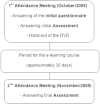Proposal of e-learning strategy to teach Atraumatic Restorative Treatment (ART) to undergraduate and graduate students
- PMID: 25034167
- PMCID: PMC4118786
- DOI: 10.1186/1756-0500-7-456
Proposal of e-learning strategy to teach Atraumatic Restorative Treatment (ART) to undergraduate and graduate students
Abstract
Background: The aim of this study was to evaluate e-learning strategy in teaching Atraumatic Restorative Treatment (ART) to undergraduate and graduate students. The sample comprised 76 participants-38 dental students and 38 pediatric dentistry students-in a specialization course. To evaluate knowledge improvement, participants were subjected to a test performed before and after the course.
Results: A single researcher corrected the tests and intraexaminer reproducibility was calculated (CCI = 0.991; 95% IC = 0.975-0.996). All students improved their performances after the e-learning course (Paired t-tests p < 0.001). The means of undergraduate students were 4.7 (initial) and 6.4 (final) and those of graduate students were 6.8 (initial) and 8.2 (final). The comparison of the final evaluation means showed a statistically significant difference (t-tests p < 0.0001).
Conclusions: The e-learning strategy has the potential of improving students' knowledge in ART. Mature students perform better in this teaching modality when it is applied exclusively via distance learning.
Figures
References
-
- Bottenberg P, Ricketts DNJ, Van Loveren C, Rahiotis C, Schulte AG. Decision-making and preventive non-surgical therapy in the context of a European Core Curriculum in Cariology. Eur J Dent Educ. 2011;15(Suppl 1):32–39. - PubMed
-
- Buchalla W, Wiegand A, Hall A. Decision-making and treatment with respect to surgical intervention in the context of a European Core Curriculum in Cariology. Eur J Dent Educ. 2011;15(Suppl 1):40–44. - PubMed
Publication types
MeSH terms
LinkOut - more resources
Full Text Sources
Other Literature Sources


